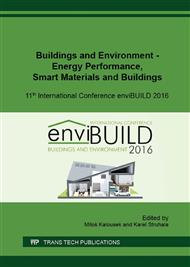p.417
p.425
p.433
p.438
p.449
p.457
p.469
p.477
p.485
Experiment Based Analysis of Complex Posterior Waterproofing Systems
Abstract:
In connection with the problems of aging European building stock, the opportunity of posterior waterproofing methods emerges as a relevant solution. There are different technologies which are suitable against rising damp in walls, but the chemical injection system through injection boreholes is the most commonly used method due to its extensive usability and fast implementation. The aim of the experimental research was to measure the efficiency of the chemical injection method by the penetration of the injection agents. There were built several specimens of small size solid bricks and some further ones of coarse limestones. The three months long research allowed to determine the moisture content of the specimens before and after the injection process. The received results were mass-based and moisture content data was measured by Protimeter. Surface coating and renovation plaster give additional moisture protection and along with the chemical injection provide a complete posterior waterproofing system. The elements of posterior waterproofing cause changes in the vapour diffusion of renovated structures. However, diffusion-open orders of layers can solve the problem of evaporation, as environmental friendly reconstruction solutions. Based on the measured results of rising damp and known characteristics of cement-based waterproofing and renovation plasters, thermal simulations and hygrothermal analysis and thus building physical conclusions have been performed.
Info:
Periodical:
Pages:
449-456
Citation:
Online since:
December 2016
Authors:
Price:
Сopyright:
© 2017 Trans Tech Publications Ltd. All Rights Reserved
Share:
Citation:


